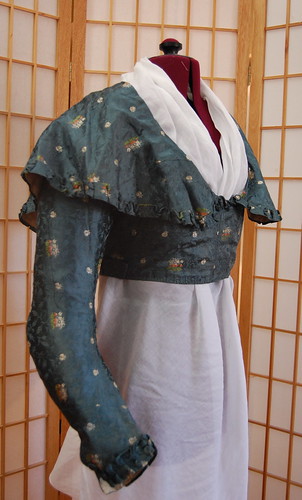
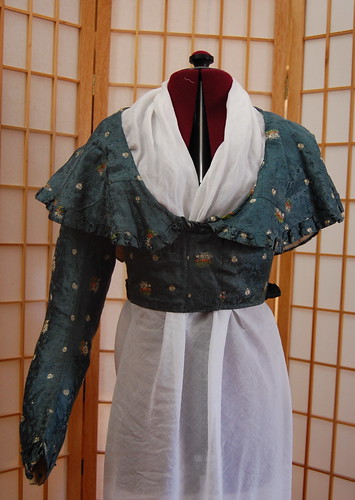

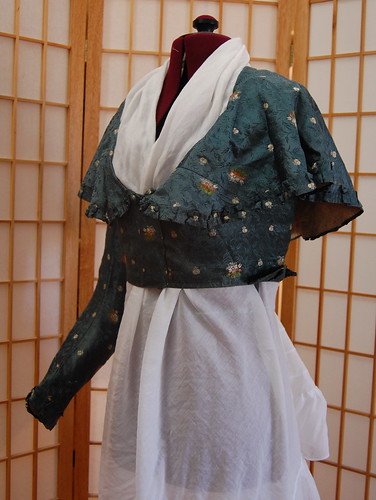
The end of the 18th century brought about dramatic changes in fashion. Dresses evolved from the structured dresses of earlier in the century, to the high-waisted, delicate dresses of the early 19th century. The 1790s were a transitional decade where dresses often blended details of the past with what was to come. One of the most striking differences was the waistline, which crept up as the decade progressed. In the early part of the decade, many dresses, such as the bodice in my collection, retained the straight front and structured lines of earlier dresses.
I have a fascination with 18th century construction techniques. They’re so different than today’s, and really quite practical. They create strong seams and a neat interior, yet are not difficult to take apart in case the dress needs to be remodeled. This bodice showcases a variety of different techniques, as each seam and edge is finished differently.
This article originally appeared on Your Wardrobe Unlock'd. It has been updated with new information about the side back seam technique.
The bodice—An Overview


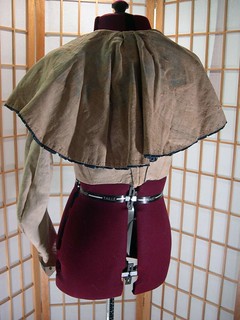
The bodice shares many features with dresses of the 1780s. It has no shaping from darts and is meant to be worn over stiff 18th century stays rather than the more natural shaped corsets that came in towards the end of the 18th and beginning of the 19th centuries. Since it is high waisted, the stays may have been shorter—perhaps of the style with padding above the tabs to help keep skirts at the raised waistline. The neckline is very low and would’ve been filled in with a fichu. It likely would’ve been paired with a matching or muslin petticoat.
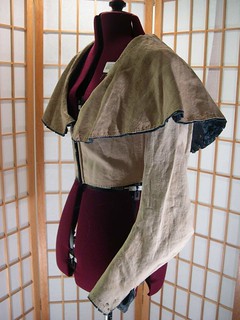
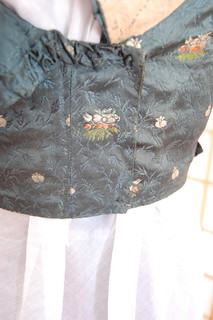
Fabrics
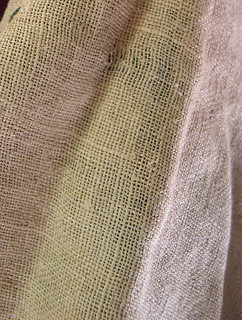
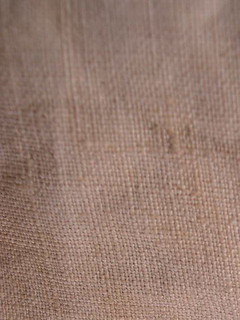
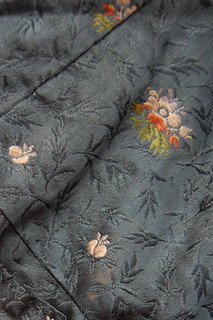
The bodice is made of a lightweight brocade lined with two different linens. The body and sleeves are lined with a smooth, tightly woven linen and the collar is lined with a coarse, loosely woven linen. The center front extension is lined with a slightly rough glazed wool twill. This is original to the bodice, not a later alteration. The stitching matches the rest of the sewing and the pleated trim from the collar extends to the edge of the extension. The bodice has no closures, so would have pinned shut. This extension would have provided not just a convenient place to pin the bodice, but would have allowed for slight flexibility in size.
The brocade is a greenish blue with peach and white flowers with green leaves and sprigs of the same greenish blue as the background.
All exterior seams are sewn with blue silk thread that matches the bodice. Interior seams are sewn with natural linen thread.
Piecing
The shoulders, collar, and sleeve are pieced. The piecing is done without much attempt to match the pattern, but the soft texture and busy pattern hide the piecing well. In addition, the shoulders of the lining and sleeve lining are pieced. In all cases, grainlines were matched. The piecing was done with a spaced backstitch and the fabrics right sides together.
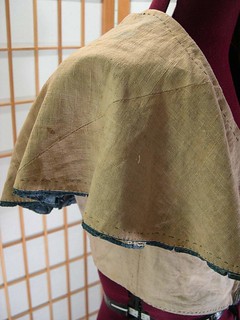

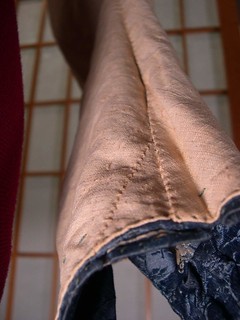
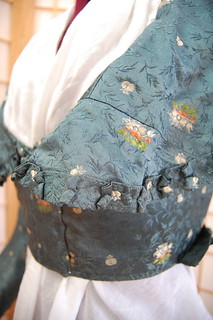


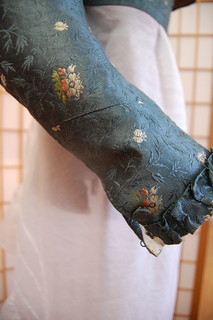
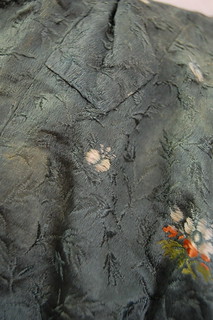
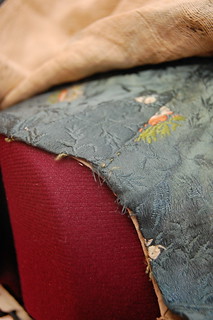

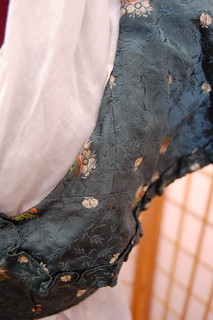
The center back neckline has a loop, presumable for hanging on a hook.
Measurements
Center Front: 5 3/8 inches
Center Back: 13 ½ inches
Underarm: 6 ½ inches
Waist, excluding overlap: 27 ¼ inches
Waist, including overlap: 29 inches
Bust, excluding overlap: 33 ¾ inches
Bust, including overlap: 34 ½ inches
Sleeve, inner seam: 18 inches
Sleeve, outer seam: 25 inches
Wrist, including overlap: 8 ½ inches
Bodice Construction
Seams
The seams are sewn with several different methods.
The shoulder seams are sewn with lapped seams.
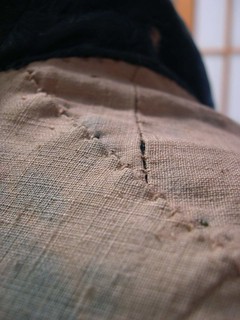
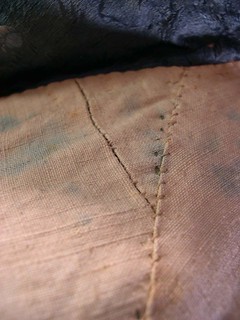
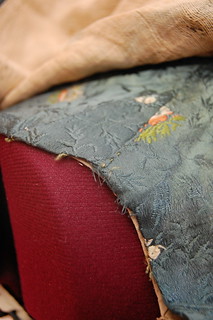
First, the brocade seam allowance on the back shoulder is folded under. This is then laid on top of both the brocade and linen lining of the front shoulder. All layers are then sewn with a spaced backstitch. To allow for finishing the edges and setting the sleeves, the first and last 1 ½ inches the brocade is sewn separately, leaving the lining loose. The blue stitches are visible on the wrong side of the seam in between these loose sections.
Next, the seam allowance of the back shoulder linen lining is folded under. This is then whipstiched to the linen front lining. This is done in linen thread and no stitches show through on the right side.
The result is the seam is very strong as it is sewn twice—first with the backstitches and then with the whipstitches—and the seam allowances are neatly covered.
This method is illustrated in Costume Close-Up by Linda Baumgarten on the c. 1775-1780 jacket.

For the center back seams, the brocade and linen layers were sewn separately, right sides together, with backstitches. The seam allowances on the linen layer were then sewn down with a running stitch to create boning casings. The linen lining would’ve been set aside as the side back seams were sewn.
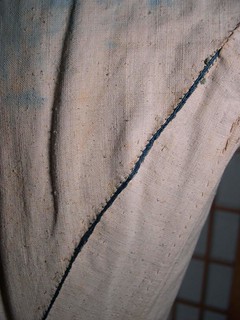
The side back seams are sewn with the same method found on the Northern Society of Costume and Textile’s Dress of the Revolution and a c. 1820-1840 corset that I own. (Please note my page is very much not updated with the new seam technique at this time!)
The seam allowances of the outer fabric and lining are folded together, and then the seams are sewn with a sort of running/whipstitch combination. I initially thought the outer fabric was sewn first and then the seam allowances were whipstitched to it (as described in the above pattern), but now believe that this technique was used. . This is also described in the Kannik’s Korner tailoring book, which I don’t own but have seen a copy of.
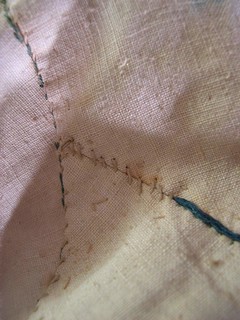
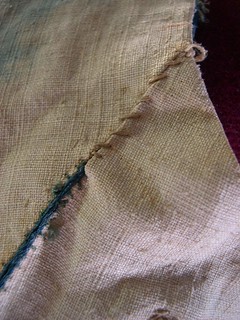
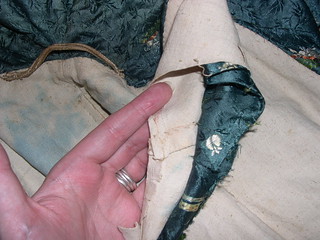
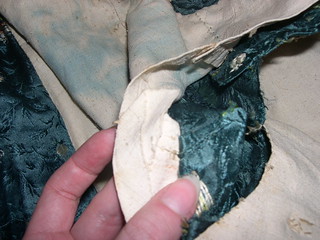
For approximately the top inch, the linen lining is just whipstitched to itself. This allows the brocade and linen to be sewn separately when the sleeves are inserted.
Edge finishing
It’s when studying construction that a missing sleeve is actually a very good thing. One detail that’s left out of current costume construction books is how to finish the edges near seams. The typical way of finishing edges in the 18th century is to turn the lining and outer fabrics towards each other and edge stitch them, and the typical way of finishing seams involves sewing the lining seams to the outer fabric seams. Sewing the lining to the outer fabric at the seams, of course, makes it impossible to turn the edges in.
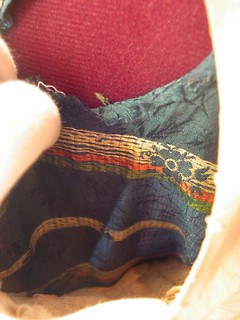
Because of the missing sleeve, it is possible to see one way this was handled. For the last inch or so, the seams are handled separately. The outer fabric is sewn only to itself, and the lining is sewn only to itself. It is then possible to turn the edges towards each other to finish them.
The finishing of the bottom edge of the bodice was handled differently. The brocade seams were sewn, the bottom edges of the brocade were turned up, and the lining seam allowances were folded in, and the lining was edge stitched to the brocade. Therefore, the bottom edge was handled the same way the seams were, with just the attaching stitch changed.
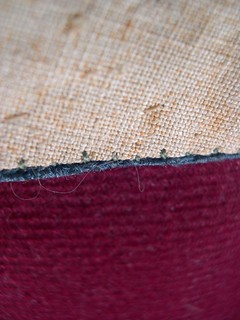
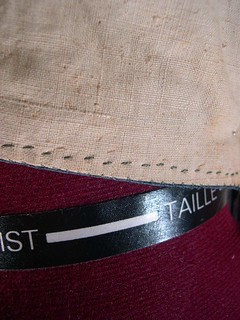
The bottom edge of the bodice is finished with a stitch called le point a rabattre sous la main. In this stitch, the seam allowances are turned in and a running stitch is taken through the outer fabric and then the needle is inserted in the back of the lining of the fold and through to the front. It creates a top stitch on the outer fabric while securing the lining so it doesn’t roll out.
I’ve taken pictures of this on my website here
And I’ve taken a short video of the process here
A running stitch was used 3/8 an inch above this to further reinforce the edge.
Sleeves
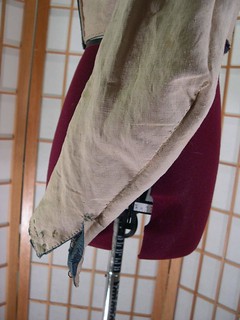
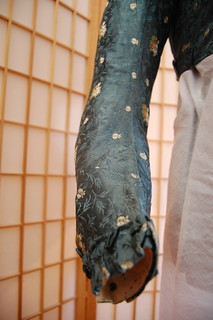
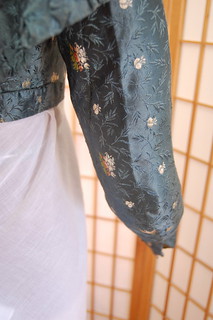
The bodice has long, one piece shaped sleeves. The top of the sleeve is cut on the straight of grain and the lower portion on the bias.
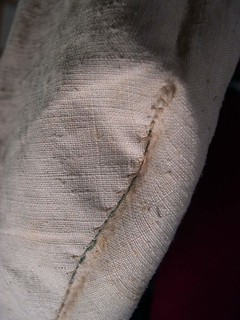
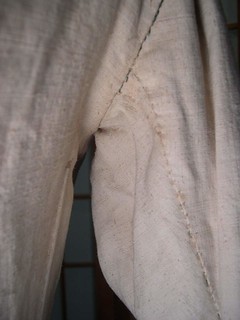
The back of the sleeve is split at the elbow and seamed below to create shaping. If the sleeve were laid flat, it would resemble a standard two piece curved sleeve with the upper portion laid back to back. The bottom of this seam is open for 3 1/2 inches to allow for a tight fit at the wrist. This opening closes with a hook and eye and a self-fabric button and loop. The hook and loop, however, are missing, with only traces of each remaining.
The front seam extends from the front corner of the armscye to the wrist.
The sleeve seams were sewn in a way similar to the shoulder seams, only without lapped seams The brocade was placed right sides together, and along with one layer of the linen lining, and sewn with backstitches. The other side of the linen was then folded under and whipstitched to the seam.
This technique is also illustrated in Costume Close-Up. It was used on the c. 1780 shortgown.
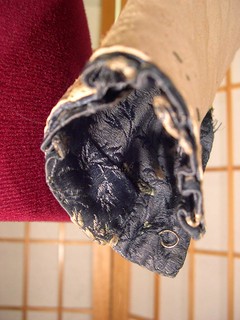
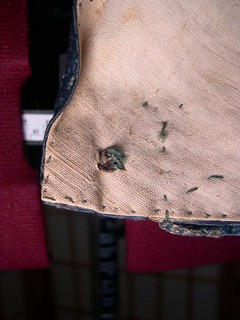
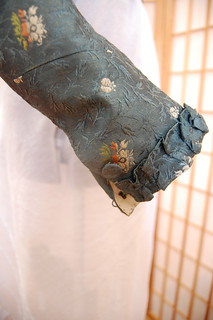
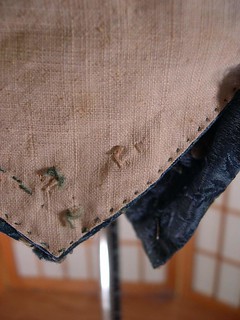
On the wrist opening, the front seam allowance is clipped in 7/16 an inch. The back then overlaps this edge, forming a sort of placket, so that when the cuff is closed, the wrist does not show through the opening. The clipped seam allowance is whipstitched at top to keep it in place.
The edges of the sleeve opening are turned in and finished with a running stitch.
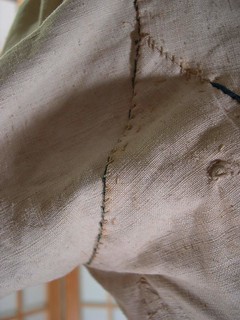
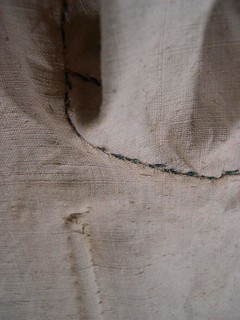
When the sleeve was set into the bodice, it was first sewn to the brocade. The seam allowances were then pressed towards the shoulder. Next, the seam allowance of the bodice lining was folded under and whipstitched along the seam line which gives a smooth finish to the armscye.
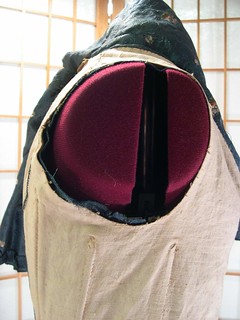

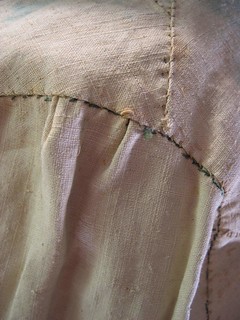
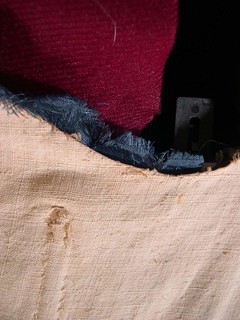
The seam allowances on the armscye missing the sleeve have been clipped along the front edge. This appears to be original to the bodice and not a result of the sleeve being removed. The clips are triangular in shape and follow the sharp curve starting at the underarm where fabric is difficult to fold.
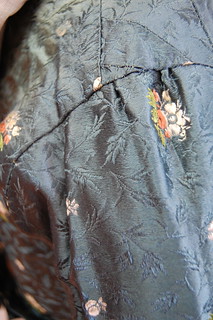
The sleeve is mostly set smoothly, with a slight amount of easing at the top of the shoulder.
Collar

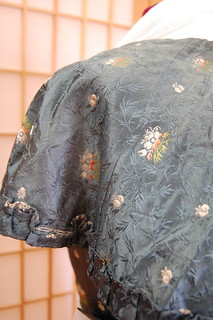
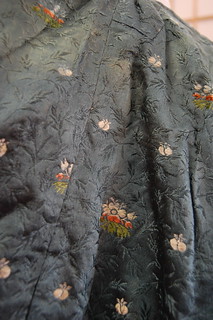
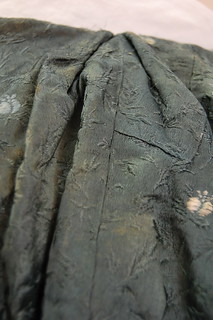
The collar is quite large and could even be called a cape. It is 11 inches long in back, 9 inches long at the shoulder, and slopes down to nothing at the center front. The bottom edge is turned under, as is the edge of the lining, and then the two pieces are stitched together with a running stitch. The two layers are also sewn together with a running stitch of blue silk thread about 1 inch from the top edge to provide stability.
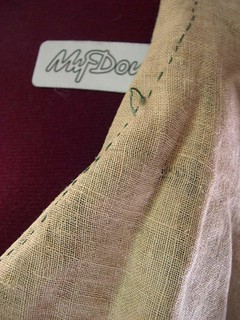
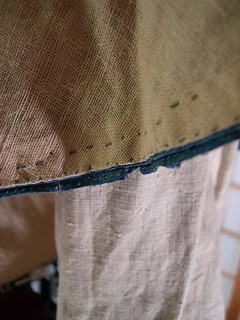
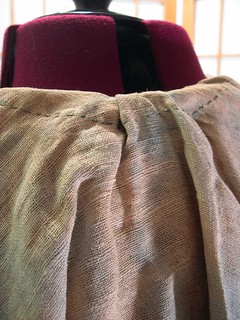
The collar is inserted between the brocade and linen lining of the neckline. The wrong side of the collar was sewn to the right side of the neckline. This seam was then folded in towards the lining. The top edge of the linen lining was then folded under and whipstitched to along the seamline. The collar was further secured with a row of running stitches in linen thread through all the layers of the seam allowances. This row of running stitches is about 1/8 an inch from the top edge.

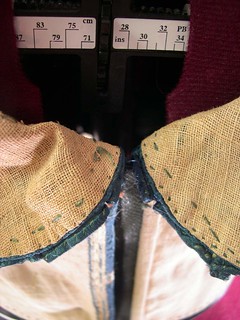

The collar mostly lies flat, but is pleated with a very small box pleat at center back.
Trim
The bodice is decorated with brocade self-fabric pleating and tabs.

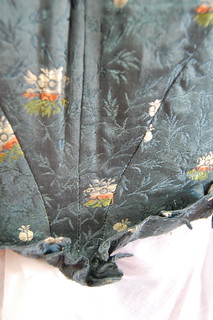
Narrow strips of brocade were hemmed and pleated around the collar and sleeve bottoms. The pleating on the collar measures one inch at center back and ¾ an inch at the front. The pleating on the sleeves measures 1 ¼ inch. The pleating is attached with a running stitch down the center.
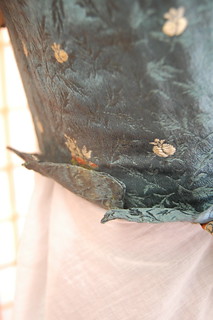

The back half of the waistline is decorated with tabs. These are trapezoidal pieces of fabric approximately 1 ¼ inches deep, 2 ½ inches at the top edge and 1 ¾ inch at the bottom edge. The tabs on the center back point are smaller, measuring 1 ½ inch at top and one inch at the bottom.
Each tab is faced with brocade. The edges were turned in and sewn together with a running stitch, creating four finished edges. They were then placed face up on the finished waistline of the bodice, each one overlapping the last. They were whipstitched into place, so they stand up at the bodice’s base.
Boning
The bodice is boned at the center front, side front, underarm, side back and center back.
The casings for the side front, side, and side back bones are sewn to the lining. They are of plain linen with unfinished edges and quite a bit wider than the bones. The tops of the bones are secured with a few stitches taken through the bones.
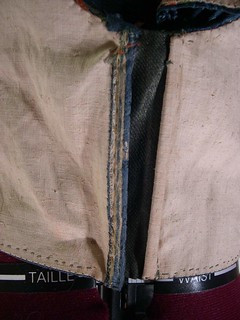
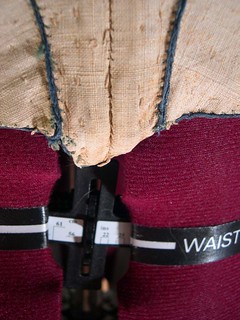
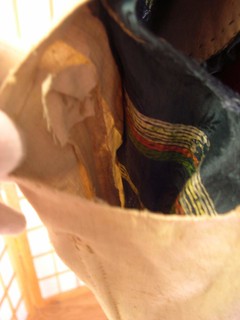
From front to back, they measure 5 ½ inches, 6 inches, and 8 inches long and measure 2 ¾ and 1 ¾ inches apart. The first bone is 6 inches away from the center front bone.
The center front is folded under and the boning is inserted into the resulting channels. On the left hand, or underlap side, the channel is made of both the brocade and linen. On the right, or overlap side, the channel is made of just linen. The brocade is then sewn next to the bone, through all layers, to keep everything in place. The stitches show on the right side, but due to the nature of the brocade are practically invisible.
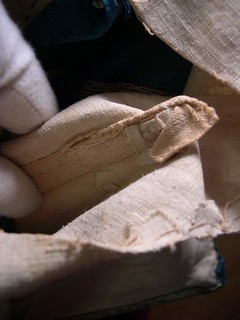
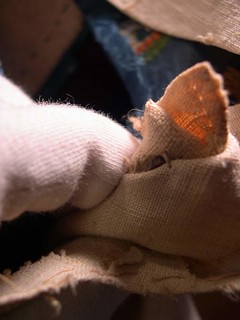
This boning is very thick, approximately 3/8 inch on the overlap side and ¼ inch thick on the underlap side. It runs the entire length of the center front, at 5 3/8 inches long.
There are two pieces of boning at center back. It is inserted into the casings made with the seam allowances. The boning is very stiff and the bottom edge is bent into a curve, which would allow it to sit nicely on a bumroll. It is 12 ½ inches long and starts 1 ½ inches from the top. The top edge of each bone is secured with two V shaped stitches taken through the bones.
I hope that this overview shed a little light on construction techniques from the end of the 18th century. I find it fascinating that so many different seam treatments were used in the same garment. I do think this is the most interesting bodice in my collection, not only because of this, but because it’s from such an underrepresented time period. I adore transitional clothing from just about any era--to be able to see how and why things change from one style to the next. I truly feel lucky to have been able to share this bodice with you.

This is absolutely amazing!!!
ReplyDeleteActually I often wished that museums' could provide us with such detailed pictures (especially of the lining and piecing!).
Thank you so much for your work putting this up as a blogpost - it's truly a gem and very much appreciated. Bliss :)
Sabine
I want to thank you very much for sharing this, as well - just what Sabine said! I actually thought I already had... so I'm amending that now. Thank you so much for all those photos and all that write up!
ReplyDelete